Find a New Home in Four Steps


Whether you’re a first-time homebuyer or a current owner looking for a bigger home, the ideas below will help you better navigate that all-important first step: Finding a property that you like (and can afford).
The search for a new home always starts out with a lot of excitement. But if you haven’t prepared, frustration can soon set in, especially in a competitive real estate market. The biggest mistake is jumping into a search unfocused, just hoping to “see what’s available.” Instead, we recommend you first take some time to work through the four steps below
Step 1: Talk to your agent
Even if you’re just thinking about buying or selling a house, start by consulting your real estate agent. An agent can give you an up-to-the-minute summary of the current real estate market, as well as mortgage industry trends. They can also put you in touch with all the best resources and educate you about next steps, plus much more. If you are interested in finding an experienced agent in your in your area, we can connect you here.
Step 2: Decide how much home you can afford
It may sound like a drag to start your home search with a boring financial review, but when all is said and done, you’ll be glad you did. With so few homes on the market now in many areas, and so many people competing to buy what is available, it’s far more efficient to focus your search on only the properties you can afford. A meeting or two with a reputable mortgage agent should tell you everything you need to know.
Step 3: Envision your future
Typically, it takes at least five years for a home purchase to start paying off financially, which means, the better your new home suits you, the longer you’ll most likely remain living there.
Will you be having children in the next five or six years? Where do you see your career heading? Are you interested in working from home, or making extra money by renting a portion of your home to others? Do you anticipate a relative coming to live with you? Share this information with your real estate agent, who can then help you evaluate school districts, work commutes, rental opportunities, and more as you search for homes together.
Step 4: Document your ideal home
When it comes to this step, be realistic. It’s easy to get carried away dreaming about all the home features you want. Try listing everything on a piece of paper, then choose the five “must-haves,” and the five “really-wants.”
For more tips, as well as advice geared specifically to your situation, connect with an experienced Windermere Real Estate agent by clicking here.
Windermere Foundation by the Numbers
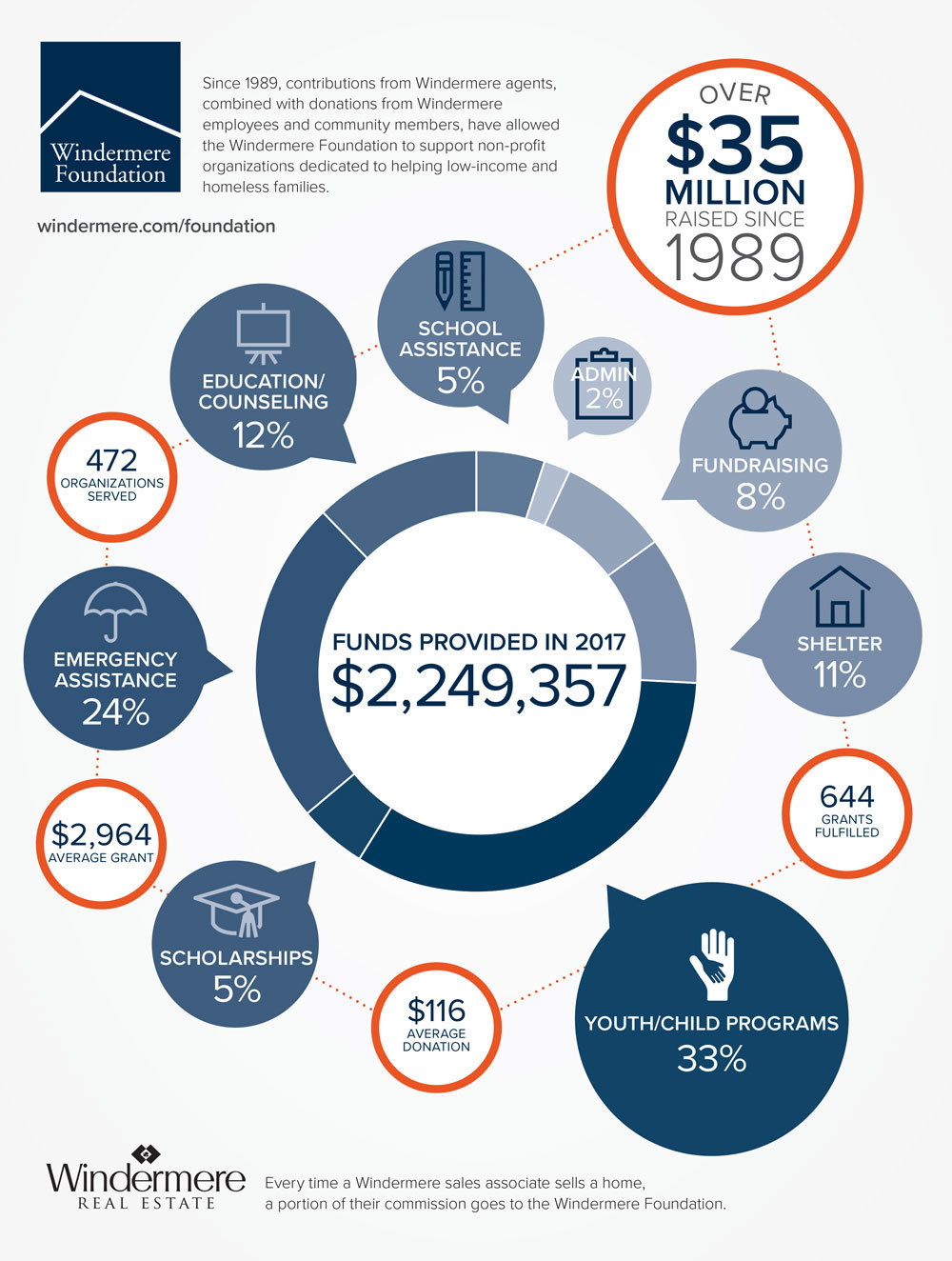

For the past 29 years, the Windermere Foundation has been helping those in need in our communities through donations to local organizations that provide services to low-income and homeless families. In 2017, the Windermere Foundation raised over $2.4 million in donations, bringing the total to over $35 million raised since we started this effort in 1989. The following infographic details exactly how these funds were dispersed in 2017 and the types of organizations that benefited from them. For more information please visit windermere.com/foundation.
Childproofing: Protect Your Family and Your Home from Potential Hazards

 When you think of your home, it likely conjures up feelings of safety, shelter, and comfort. However, accidental injuries in the home are one of the leading causes of harm to children 14 and younger. By taking certain precautions, many of these accidents can be prevented.
When you think of your home, it likely conjures up feelings of safety, shelter, and comfort. However, accidental injuries in the home are one of the leading causes of harm to children 14 and younger. By taking certain precautions, many of these accidents can be prevented.
While supervision is the best way to keep your children safe at home, you can’t watch them every second. Childproofing, to whatever degree you are comfortable, will go a long way toward keeping your littlest loved ones safe and healthy at home.
Here are some tips to get you started.
Many accidents happen with or around water.
If you have children at home, it’s advisable to adjust your water heater to no higher than 120 degrees to prevent scalding. Furthermore, you should never leave a small child unattended in a bath tub, even for a few seconds. And be sure to safely secure doors that lead to swimming pools and hot tubs, including pet doors. When cooking or boiling water, turn pot handles in, or better yet use the back burners, to prevent little hands from pulling them off the stove.
Household chemicals can be very harmful to children.
It’s important not to keep poisonous materials under the sink, even if you have a cabinet guard in place. Keep dangerous chemicals up high and in a room that isn’t accessible to your little ones. Seemingly innocuous medicines can also be dangerous. Make sure your medicine cabinet is out of sight, mind, and reach.
Use safety latches and gates.
It’s advisable that you use safety latches on drawers, cabinets, toilets, and windows, as well as place covers on all electrical outlets. Gate off stairways and entrances to rooms, such as garages, that contain dangerous or fragile objects.
Secure furniture and other objects.
Heavy furniture, electronics, and lamps must be secured to prevent a child from pulling them over. Bookshelves and entertainment centers often come with devices that attach them to walls so that a climbing child won’t topple the furniture. The end-caps on door stoppers can be a choking hazard, so it’s advisable to remove them. Place plastic bumpers on sharp corners or edges of coffee tables, entertainment centers, and other furniture to prevent cuts and bruises.
Install a carbon monoxide detector.
The U.S. Consumer Product Safety Commission (CPSC) recommends that consumers purchase and install carbon monoxide detectors in addition to smoke alarms. Be sure to test both devices regularly and replace batteries as needed. The American Red Cross advises families to learn first aid and CPR, and to devise an emergency evacuation plan for fires and earthquakes.
Emergency contact info.
Last, but not least, in case an emergency does happen, always keep numbers for your child’s doctor, your work and cell, and other emergency contact info in an easily found place, preferably near the phone.
Accidents can and will happen, but by following a few small steps you can have peace of mind knowing that you’ve done everything you can to protect your family from harm in your home.
For more information on Windermere Evergreen, please contact us here.
Outdoor Living Trends
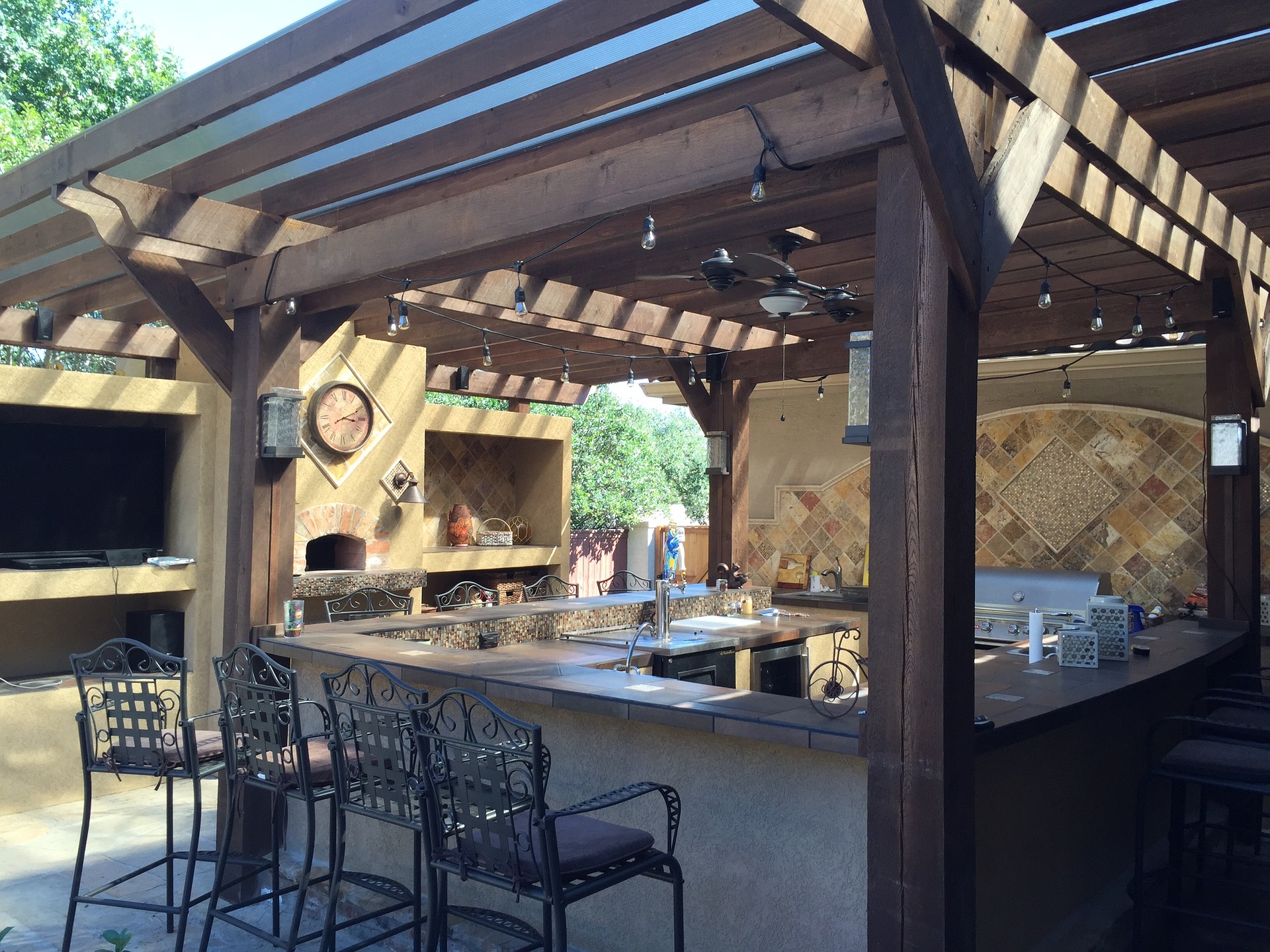

Summer is just around the corner and there is no better way to prepare than indulging in some exciting backyard inspiration. Your outdoor living space can be more than just a place to spend time with family and friends; it can be your sanctuary as well. This year is the time to turn your backyard into your own personal vacation spot.
If you don’t have a tub already, consider adding a sunken hot tub into your backyard with a deck of natural stone, tall grasses, and outdoor curtains for privacy. Include pillar candles and some twinkling lights for ambiance.
If you entertain a lot, a kitchen is the ideal outdoor space for summer entertaining. Bring out your inner Bobby Flay with a cooking station that includes a high-end grill, refrigerator, wine chiller, and elegant washbasin. Round this all out with a concrete counter, bluestone tile floor, and stainless steel.
Nothing says summer like outdoor movies and your own personal drive-in. All you need is a projector to watch your favorite movie, some dangling lights in the trees, blankets, and pillows. You could also watch it from a hanging bench or my personal favorite, a floating bed.
Gardening can go beyond being a relaxing pastime; consider growing your favorite foods and join the “farm to table” movement. In 2012, people spent $1.2 billion more dollars on food gardening than they did flower gardening. An easy way to incorporate this is to use blueberries as foundation plants or other fruits, such as raspberries. If you already have flowers planted, tuck a pepper plant or basil in between your flowers.
A reading nook outdoors is the perfect way to get lost in your favorite book or magazine. You can convert a small shed into a private reading spot, an arbor with a bench surrounded by clematis, or a relaxing hammock. These hideaway spots are what turn your home into a staycation resort.
Is your ideal summer situated by a campfire? Build a fire pit and enjoy s’mores in the comfort of your backyard. Use an old wine barrel, bricks, stones, or a concrete bowl. A lowered fire pit is great if you want to use sand for a beachy atmosphere. On a warm summer night a campfire sets just the right mood for outdoor fun.
Having a water feature in your backyard instantly creates a Zen space. They can deflect unwanted attention by drowning out unwelcome sounds. Add a fountain, pondless waterfall, or small stream to complete the vibe. If you want a smaller commitment, a shallow recirculating foundation will also do the trick. All you need is a simple foundation and recirculating pump.
To enhance your space with little to no cost, add dangling vines or twinkling lights as a finishing touch to create your backyard haven. Time is something there never seems to be enough of, but these low-maintenance enhancements will enable you to spend that time in your very own outdoor living space.
For more outdoor living ideas, follow our Pinterest board.
For more information on Windermere Evergreen, please contact us here.
Is a “home exchange” vacation right for you?
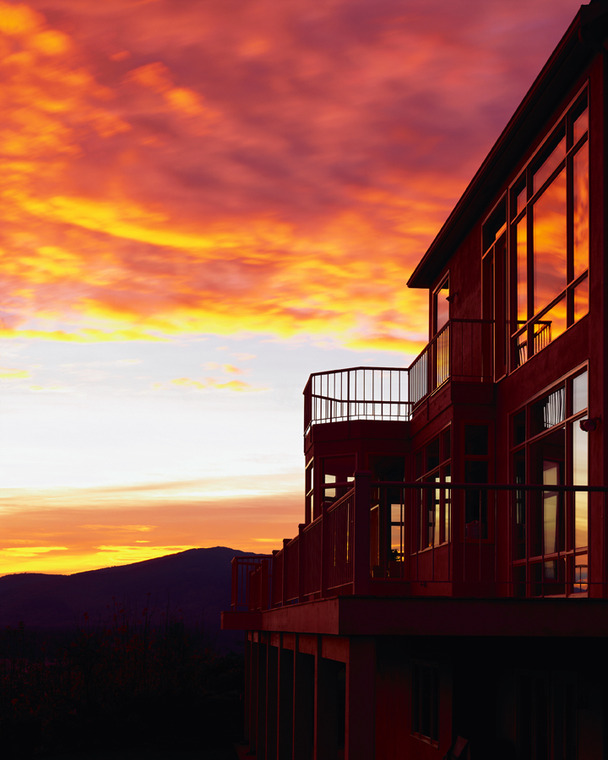
It is finally summer; time for barbecues, summer camp, and family vacations. In recent years we’ve heard of people shortening their vacations, staying closer to home, or going nowhere at all for “staycations”. Another way to save money, while still getting away, is to leverage your own home for a home exchange.
A home exchange—often called “house-swapping”—is a money-smart vacation idea that’s been around for a long time. With virtually everyone feeling the economic squeeze, some exchanges are more popular than ever before.
Why a home exchange? Since accommodations are usually the priciest part of a vacation, a home exchange saves money, allowing travelers to take longer vacations and perhaps splurge a bit on dining, tours, or shopping. Larger families appreciate how homes meet their needs for space, meals, and a good night’s sleep. And, home-swappers often say they enjoy “living like the locals,” especially when traveling internationally.
How it works. The basic idea of a home exchange is that two families agree to live in each other’s home (usually at the same time) at no cost—it’s considered an even trade. Exchangers find one another via home exchange website that provides detailed listings of available homes. Exchanges take place within the United States or internationally, and the length of stay is whatever the parties agree upon. Exchangers typically do not meet in person but get acquainted via phone calls and emails before the exchange happens. Details, including pets, the use of a car, and cleaning are all agreed upon ahead of time, usually in a written contract provided by the website.
What makes a house desirable? You might be surprised! As a general rule, home exchangers are looking for location, location, location. They want to explore attractions in your area, attend an event, or visit family. A beachfront house in California is highly desirable, as is a condo in an exciting city—and even a home in the suburbs will appeal to the right travelers. Because swappers are primarily looking for a convenient jumping-off point for their adventures, your home’s age, floor plan, and furnishings don’t matter too much, as long as it’s clean, comfortable, and accommodating.
Vacation homes are ideal. Whether it’s a rustic cottage on a secluded fishing lake or a condo at a popular ski area, a second home is ideal for exchanges. Logistically, you don’t have to vacate your primary residence, and you have more flexibility as to when the swap can happen. For this reason, many retirees—who often own second homes and enjoy freer schedules—find home exchanges especially appealing.
First steps. If you’re intrigued, start by exploring a few websites; you can view a lot of information for free. Home exchange websites typically charge an annual membership fee of $50 to $100 to list your home. If you decide to join a service, you’ll provide several photos and a detailed description of your home. You’ll also post your desired destination(s) and travel dates, and you’ll be able to peruse the homes that meet your criteria. It’s common to trade information with several homeowners before finding just the right match, and the process may take several months.
Focus on the basics. Once you’ve agreed to an exchange and are preparing your home for guests, think about what makes a hotel room enjoyable. A clean, clutter-free home is universally appealing, and comfortable mattresses and attractive bedding are a must. Your kitchen should be well organized, and internet access is a big plus. Your guests know they’re staying in someone’s home, so don’t worry about scuffed baseboards and well-worn furniture. Likewise, don’t expect five-star accommodations when you step into your host’s home.
Is a home exchange right for you? If the very thought of others living in your home and sleeping in your bed—or you in theirs—makes your palms go clammy, an exchange is probably not for you. But many travelers are hooked!
What are your summer vacation tips?
For more information on Windermere Evergreen, please contact us here.
Damage Control: Preparing for Winter Storms
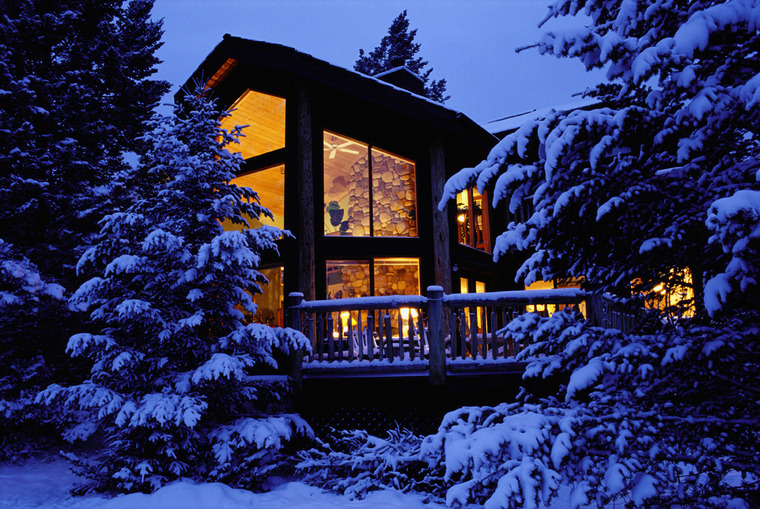
 Last week we shared tips for preventive home maintenance to help you and your home fare better through the winter months. This week we want to take this topic a bit further by focusing on disaster preparedness. No one wants to think about disasters, but being organized can help bring you and your family a peace of mind. Here are some tips for preparing for events, such as major winter storms, natural disasters, and evacuations. In the coming weeks, we will have more on how to stock an emergency kit and manage property damage.
Last week we shared tips for preventive home maintenance to help you and your home fare better through the winter months. This week we want to take this topic a bit further by focusing on disaster preparedness. No one wants to think about disasters, but being organized can help bring you and your family a peace of mind. Here are some tips for preparing for events, such as major winter storms, natural disasters, and evacuations. In the coming weeks, we will have more on how to stock an emergency kit and manage property damage.
Power Outages
Power outages are relatively common during large weather-related events; however, losing power for a few days can be highly inconvenient – and even dangerous. If you aren’t in immediate danger, you will want to make sure you are prepared with some basic necessities to survive the cold, darkness, and boredom that can accompany days without electronic stimulants.
· Keep a supply of flashlights and batteries on hand. These items easily find their way to the back of drawers, or misplaced in rooms. Make sure they are easy to find in absolute darkness. Keep flashlights in your bed side table and use a magnet to secure a flashlight to your fridge. Keep plenty of batteries on hand; in the case of an emergency, batteries can be very difficult to find.
· Don’t rely on candles. Candles are dangerous if you have pets or small children, and they can also cause a fire if not properly attended.
· Have a crank or battery powered AM/FM radio available so you can keep up on the news.
· Use your cell phone sparingly or use a charger with an alternative energy source to make sure your phone is fully changed during an emergency situation.
· When preparing for the winter season, make sure you stock up on food that is easy to eat without the help of a microwave or stove.
· Keep your refrigerator cold. The more often you open the fridge, the more quickly the temperature will rise and your food will spoil. Here is a useful guide for how long food will last after an outage.
· If you have small children, keep a stock of activities to entertain them without the aid of electricity.
· You may be able to use a BBQ if the weather is permitting or if you have a covered patio. It is very important to remember to never bring your BBQ inside for food consumption or heat. Using a BBQ or generator inside can lead to carbon monoxide poisoning.
Natural Disasters
In the instance of a natural disaster, such as a tsunami or earth quake, turn off your water heater and gas tanks. Gas leaks can be very dangerous, so if you smell gas or hear a blowing or hissing noise, you will want to leave the premises immediately and call your gas provider. If you are concerned for your family’s safety in your home, follow an evacuation plan (see “Evacuations” below).
If you are preparing for a major wind storm or hurricane/tornado, you may actually have some forewarning. In that instance, here are some helpful tips:
· Secure furniture to walls. If you live in earthquake prone territories (or have small children), securing tall bookshelves to your wall is a must. This will reduce damage and decrease the odds that someone will get injured.
· Bring outdoor items inside, including your patio furniture, pots, barbeques, etc. These items could get lost or cause greater damage to your property.
· In high wind situations, use storm shutters or board up your windows to prevent trees or other objects from causing damage.
· Fill your bathtub with clean water. In the event that water is shut off, this will be valuable for flushing the toilet and personal hygiene.
· If you have a fireplace or a wood burning stove, stock up on firewood to ensure your home stays warm.
Evacuations
During a weather-related emergency, your first priority is usually to stay in the safety of your own home. But sometimes this is not possible. With the help of your family, it’s a good idea to make an evacuation plan. Here are some possible issues to consider:
· Come up with a plan. If something should happen, it is best that everyone knows what the drill is ahead of time. Have a plan about where the family meets, a backup place to stay, and if you have family pets, how they will be evacuated, as well.
· A designated place to meet if your family cannot evacuate together.
· Designate a spot in your house and store all important documentation together, so someone can grab copies of birth certificates, home inventory, insurance documents, etc.
· Create a list of other important items you would like to take in case of an emergency, such as family heirlooms, a toy, a laptop, etc. Each person should know what those special items are, and be able to grab them quickly.
· And don’t forget to practice your plan together as a family.
For more information on Winderemere Evergreen, please contact us here.
Baby Boomers Have Homebuilders Rethinking Home Design

 The baby boomer generation, which is currently estimated to be aged between 48 and 67 years old, comprises almost one-third of the nation’s population. The demand that this lucrative segment of the population has on housing is causing homebuilders to rethink how they design homes. In fact, the National Association of Home Builders (NAHB) has a 50+ Housing Council which focuses entirely on the housing needs of aging baby boomers. A study commissioned by the NAHB suggests that baby boomers and older homebuyers want a maintenance-free lifestyle that frees them up to travel, socialize, and pursue other activities. Perhaps this is why real estate professionals report an increase in the number of baby boomers who are interested in condominiums and townhomes. There is also growing popularity for luxury units because they appeal to empty-nester baby boomers who no longer want the maintenance of a single family home, but don’t want to scale back on certain features and amenities either.
The baby boomer generation, which is currently estimated to be aged between 48 and 67 years old, comprises almost one-third of the nation’s population. The demand that this lucrative segment of the population has on housing is causing homebuilders to rethink how they design homes. In fact, the National Association of Home Builders (NAHB) has a 50+ Housing Council which focuses entirely on the housing needs of aging baby boomers. A study commissioned by the NAHB suggests that baby boomers and older homebuyers want a maintenance-free lifestyle that frees them up to travel, socialize, and pursue other activities. Perhaps this is why real estate professionals report an increase in the number of baby boomers who are interested in condominiums and townhomes. There is also growing popularity for luxury units because they appeal to empty-nester baby boomers who no longer want the maintenance of a single family home, but don’t want to scale back on certain features and amenities either.How long should they last?
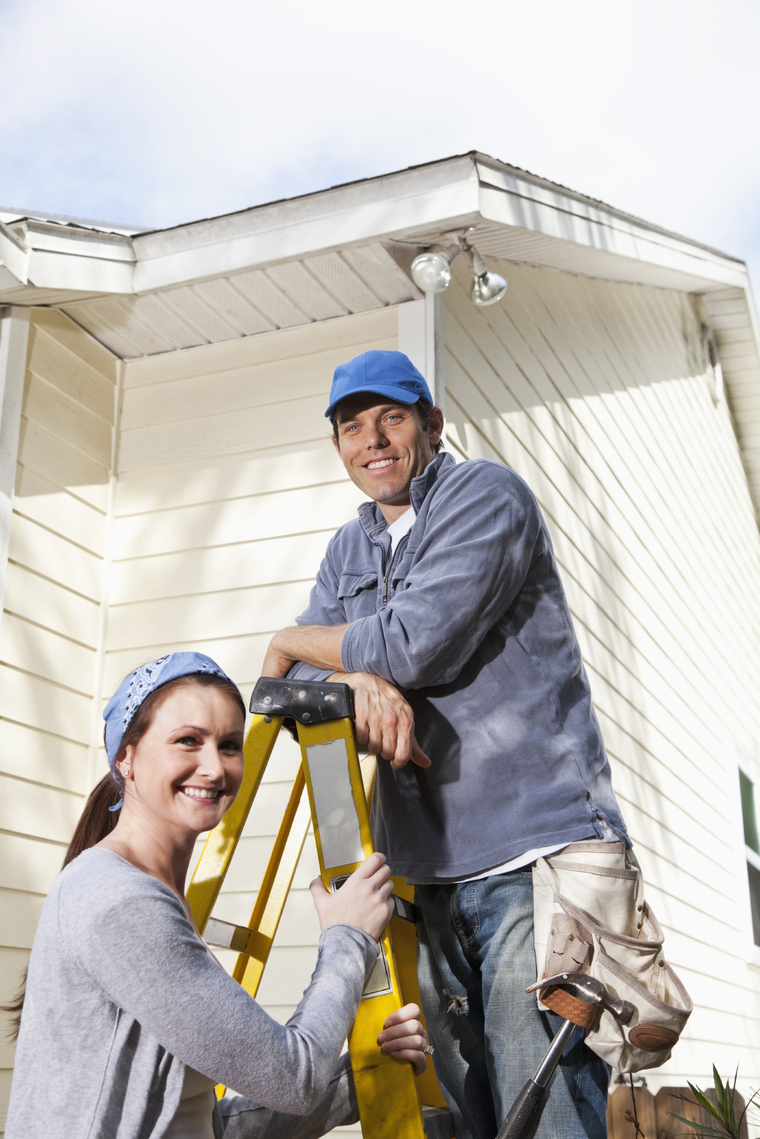
 Nothing in life lasts forever – and the same can be said for your home. From the roof to the furnace, every component of your home has a life span, so it’s a good idea to know approximately how many years of service you can expect from them. This information can help when buying or selling your home, budgeting for improvements, and deciding between repairing or replacing when problems arise.
Nothing in life lasts forever – and the same can be said for your home. From the roof to the furnace, every component of your home has a life span, so it’s a good idea to know approximately how many years of service you can expect from them. This information can help when buying or selling your home, budgeting for improvements, and deciding between repairing or replacing when problems arise.
According to a National Association of Home Builders (NAHB)study, the average life expectancy of some home components has decreased over the past few decades. (This might explain why you’re on your third washing machine while Grandma still has the same indestructible model you remember from childhood.) But the good news is the life span of many other items has actually increased in recent years.
Here’s a look at the average life spans of some common home components (courtesy of NAHB).
Appliances. Of all home components, appliances have the widest variation in life spans. These are averages for all brands and models, and may represent the point which replacing is more cost-effective than repairing. Among major appliances, gas ranges have the longest life expectancy, at about 15 years. Electric ranges, standard-size refrigerators, and clothes dryers last about 13 years, while garbage disposals grind away for about 10 years. Dishwashers, microwave ovens, and mini-refrigerators can all be expected to last about nine years. For furnaces, expect a life span of about 15 years for electric, 18 for gas, and 20 for oil-burning models. Central air-conditioning systems generally beat the heat for 10 to 15 years.
Kitchen & Bath. Countertops of wood, tile, and natural stone will last a lifetime, while cultured marble will last about 20 years. The life span of laminate countertops depends greatly on use and can be 20 years or longer. Kitchen faucets generally last about 15 years. An enamel-coated steel sink will last five to 10 years; stainless will last at least 30 years; and slate, granite, soapstone, and copper should endure 100 years or longer. Toilets, on average, can serve at least 50 years (parts such as the flush assembly and seat will likely need replacing), and bathroom faucets tend to last about 20 years.
Flooring. Natural flooring materials provide longevity as well as beauty: Wood, marble, slate, and granite should all last 100 years or longer, and tile, 74 to 100 years. Laminate products will survive 15 to 25 years, linoleum about 25 years, and vinyl should endure for about 50 years. Carpet will last eight to 10 years on average, depending on use and maintenance.
Siding, Roofing, Windows. Brick siding normally lasts 100 years or longer, aluminum siding about 80 years, and stucco about 25 years. The life span of wood siding varies dramatically – anywhere from 10 to 100 years – depending on the climate and level of maintenance. For roofs, slate or tile will last about 50 years, wood shingles can endure 25 to 30 years, metal will last about 25 years, and asphalts got you covered for about 20 years. Unclad wood windows will last 30 years or longer, aluminum will last 15 to 20 years, and vinyl windows should keep their seals for 15 to 20 years.
Of course, none of these averages matter if you have a roof that was improperly installed or a dishwasher that was a lemon right off the assembly line. In these cases, early replacement may be the best choice. Conversely, many household components will last longer than you need them to, as we often replace fully functional items for cosmetic reasons, out of a desire for more modern features, or as a part of a quest to be more energy efficient.
Are extended warranties warranted?
Extended warranties, also known as service contracts or service agreements, are sold for all types of household items, from appliances to electronics. They cover service calls and repairs for a specified time beyond the manufacturer’s standard warranty. Essentially, warranty providers (manufacturers, retailers, and outside companies) are betting that a product will be problem-free in the first years of operation, while the consumer who purchases a warranty is betting against reliability.
Warranty providers make a lot of money on extended warranties, and Consumers Union, which publishesConsumer Reports, advises against purchasing them. You will have to consider whether the cost is worth it to you; for some, it brings a much needed peace of mind when making such a large purchase. Also, consider if it the cost outweighs the value of the item; in some cases it may be less expensive to just replace a broken appliance than pay for insurance or a warranty.
For more information on Windermere Evergreen, please contact us here.
Five Essentials for Your Home Office
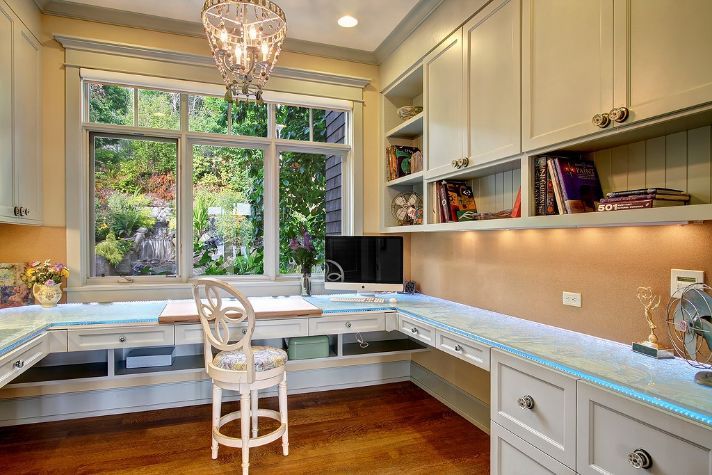
 Most people dream of working from home, but ask anyone who does it on a regular basis, and they’ll tell you how hard it can be to stay productive when you work where you live. The most disciplined telecommuters will tell you that you need a structured routine and organization to rise and grind and get into work mode.
Most people dream of working from home, but ask anyone who does it on a regular basis, and they’ll tell you how hard it can be to stay productive when you work where you live. The most disciplined telecommuters will tell you that you need a structured routine and organization to rise and grind and get into work mode.
Having a designated work space is quite possibly the most important piece to the WFH pie. Even if you live in a small space, you need to find a balance between home and office. People who work from home often have a difficult time separating work hours from their non-work hours because it’s so easy to keep at it late into the night. But maintaining a balance and shutting down the computer is important for overall wellbeing. What are some other must-haves for a successful home office? Here are the top five:
- Natural Light – Study upon study tells us that natural light is needed to boost productivity and mood. Make sure to set your desk up as close to a window as you can. If being near a window isn’t an option, a natural light lamp is the next best thing. It helps balance your body clock and leaves you feelings rested and refreshed.
- To-Do List or Planner – Start each day off by making a to-do list outlining what you need to get done before the end of the work day. Make sure to set a realistic time frame in which all of that should be completed, so you can check each one off the list and feel immense accomplishment once you’ve completed them all.
- Storage – If you have a big enough space, put in a large bookshelf where you can organize everything (think storage boxes). It reduces clutter and looks stylish. Using your walls and cabinetry is the most efficient use of space.
- Calendar – Many people tend to rely on digital calendars these days because of their convenience. When all of your devices sync together and pop up with reminders, you never have to worry about missing an appointment. However, many people find that it helps to keep a paper calendar handy too so you can easily view your whole month at a glance.
- Space for Inspiration – It doesn’t matter what field you work in, having a source of inspiration in your work space is essential. Whether it’s a photo of your family, your dream car, or that vacation you’ve been dying to take, having that inspiration right in front of you provides a constant reminder of why you do what you do.
For more information on Windermere Evergreen, please contact us here.
 Facebook
Facebook
 X
X
 Pinterest
Pinterest
 Copy Link
Copy Link

